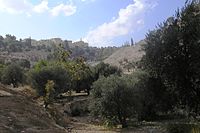Gehenna
From Wikipedia, the free encyclopedia
Gehenna (also gehenom or gehinom) (Hebrew:גהינום) is equated in Christian theology with the concept of hell. The name is derived from a geographical site in Jerusalem known as the Valley of Hinnom, one of the two principal valleys surrounding the Old City.
Gehenna is cited in the New Testament and in early Christian writing to represent the place where evil will be destroyed. It lends its name to Islam's hell, Jahannam. In both Rabbinical Jewish and Christian writing, Gehenna as a destination of the wicked is different from Sheol, the abode of the dead.
Contents |
[edit] Etymology
"Gehenna" is the Christian rendering of "Ge Hinnom," literally "Valley of Hinnom," known in Hebrew as Gai Ben-Hinnom, literally the "Valley of Hinnom's son." In the Qur'an, gehenna (Gehennem, Jahannam) is a place of torment for sinners or the Islamic equivalent of hell.
In the Hebrew Bible, Gai Ben-Hinnom does not refer to hell but rather to a real valley in Jerusalem (Joshua 15:8, Joshua 18:16, 2nd Kings 23:10, 2 Chronicles 28:3, 2nd Chronicles 33:6,Nehemiah 11:30, Jeremiah 7:31~32, Jeremiah 19:2, Jeremiah 19:6, Jeremiah 32:35). Garbage from the walled city was burned there.
[edit] Geography
The Valley of Hinnom is located below the southern wall of ancient Jerusalem. It stretches from the foot of Mount Zion eastward to Kidron Valley.In the King James Version of the Bible, the term appears 13 times in 11 different verses as "valley of Hinnom," "valley of the son of Hinnom" or "valley of the children of Hinnom."
[edit] History
In ancient times, it is believed that children were sacrificed to the pagan god Molech in Gehenna, a practice that was outlawed by King Josiah (2 Kings, 23:10). Biblical commentator Rashi explains that priests would bang on drums (Hebrew: tof, tupim) (Hebrew: תופים) so fathers would not hear the groans of children being sacrificed. Hence the name Topheth. Fires were kept burning and the valley became the garbage dump of the city. The dead bodies of criminals, and the carcasses of animals were also thrown there.
[edit] Christian New Testament references
In the synoptic gospels Jesus uses the word Gehenna 11 times to describe the opposite to the life during the promised, coming Kingdom.[1] It is a place where both soul and body could be destroyed (Matthew 10:28) in "unquenchable fire" (Mark 9:43).
In the Gospel of Matthew 23:33, Jesus observes, "Ye serpents, ye generation of vipers, how can ye escape the damnation of gehenna?”. The word gehenna is also found in the epistle of James, where it is said to set the tongue on fire. Many Christians understand gehenna to be a place of eternal punishment called hell.[2] On the other hand, annihilationists understand gehenna to be a place where sinners are utterly destroyed, not tormented forever. Christian Universalists, who believe that God will eventually save all souls, interpret the New Testament references to Gehenna in the context of the Old Testament, and conclude that it always refers to the imminent divine judgment of Israel and not to eternal torment for the unsaved.
The New Testament refers to Hades as a destination of the dead. Hades is portrayed as a different place from gehenna. Yet, even so, the Book of Revelation describes the final destination of hades as the Lake of Fire (Revelation 20:14), which many Christians today interpret as meaning the same thing as gehenna.
[edit] See also
[edit] References
- ^ Blue Letter Bible. "Dictionary and Word Search for geenna (Strong's 1067)".
- ^ Metzger & Coogan (1993) Oxford Companion to the Bible’’, p243.
[edit] External links
| Wikimedia Commons has media related to: Gehenna |
| Wikimedia Commons has media related to: Valley of Hinom |
- Daily Bible Study page on the Valley of Hinnom
- Columbia Encyclopedia on the Valley of Hinnom
- Biblical Proper Names on the Valley of Hinnom
- Gehenna from the 1901-1906 Jewish Encyclopedia
- The Jewish view of Hell on chabad.org
- A Christian Universalist perspective from Tentmaker.org
|
|||||||||






